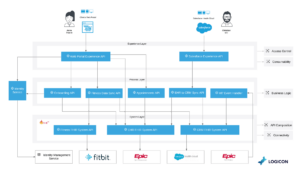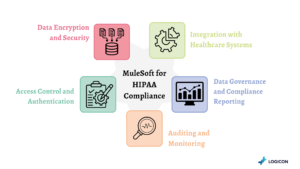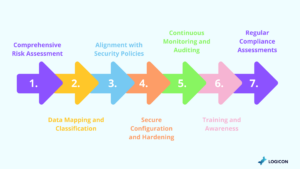Scared of how you will secure the healthcare information of your patients without compromising confidentiality? Healthcare organizations face a daunting challenge: achieving HIPAA compliance and working with the growing complexity of data integration. With technology becoming so ingrained as part of our everyday lives, it’s no wonder that the risk of data breaches and compliance violations is higher than it’s ever been. That is where Healthcare data security with MuleSoft will be effective.
In this blog, we’ll cover the ways MuleSoft is the healthcare data security superhero that can assist you in beating HIPAA compliance with expert skills. From encryption to access control, let us help you discover how MuleSoft’s high-end and fool-proof features can keep your data from snooping eyes and make sure every step is in line with the laws. Let’s jump right in.
What is HIPAA Compliance?
HIPAA compliance stands for adherence to the regulations set out in the HIPAA law that was passed in 1996. Such regulations have the purpose of preserving PHI confidentiality through their development of security, privacy, and confidentiality standards.
HIPAA Compliance is of paramount importance for healthcare organizations, such as physicians, health plans, and healthcare clearinghouses, as well as their business associates.
It covers different regulations such as the Privacy Rule, Security Rule, and Breach Notification Rule which describe the required measures for protecting PHI, getting access to health information, and reporting data breaches. Compliance results in the prevention of unwanted access, breaches, and misuse of patient data, thus ensuring patients’ trust and avoiding penalties for non-compliance.
Challenges in Healthcare Data Security
- Dynamic Cybersecurity Threats: Healthcare organizations are exposed to multiplying risks like malware, ransomware, phishing and so on which endanger the integrity, and the confidentiality of patient data.
- Proliferation of Digital Devices: The complexity of managing multiple interdependent devices and systems provides a platform for the attackers to target the security framework, which leaves the system open to breaches.
- Balancing Accessibility and Security: Healthcare providers are faced with a fine line between comfortably guaranteeing data accessibility and usability and complying with the strict security guidelines embedded in regulations such as HIPAA.
- Human Factor: Employees may not deliberately or intentionally but the risk that they pose to data security through negligent handling of patient records or unauthorized access is just as high, if not higher.
- Budget Constraints and Resource Limitations: The dearth of resources sometimes hinders healthcare organizations’ ability to allow for the implementation of highly advanced security measures and to keep up with the latest trends in cybersecurity, which necessitates the creation of new approaches to overcome such barriers.
Introduction to MuleSoft

MuleSoft is a platform that enables the integration of multiple systems, applications, and data sources, making it a seamless experience. It serves as a central site where intra-enterprise communication and interoperability in healthcare can be established among diverse technologies.
Key points to note about MuleSoft:
- Integration Hub: MuleSoft works as the integration hub and helps organizations simplify data exchange and information streams among different systems and apps. It helps to integrate seamlessly legacy systems with cloud applications, APIs, and IoT devices to create a data flow environment where data is processed quickly.
- Anypoint Platform: MuleSoft’s Anypoint Platform, which is the company’s core offering, offers a complete collection of tools, services, and interfaces for integration development, management, and monitoring. It covers the design part to create the integrations, the runtime environment to deploy and run the integrations, and the management part with tools to monitor the performance and ensure reliability.
- API-Led Connectivity: With its API-first approach, MuleSoft takes APIs as the primary building blocks for reusable integrations. When functions are exposed via APIs, it helps to increase organizational agility, scalability, and reusability of integration efforts. And as a result, faster innovation, and adaptability of changes in business needs will become possible.
- Security and Compliance: MuleSoft security and compliance get top priority, where many advanced mechanisms are provided to safeguard data, access management, and compliance with the regulations. It supports compliance with industry standards like HIPAA, GDPR, and PCI DSS. It ensures that personal information is well protected and reduces the risk of customers losing confidence in the company.
Leveraging MuleSoft for HIPAA Compliance

Data Encryption and Security:
MuleSoft is a solution that gives advanced encryption to protect healthcare data while it travels through various systems and applications. Through encryption of data stated at rest and in transit, MuleSoft gives a guarantee that patient data remains protected from unauthorized access or breach of data and thus meets HIPAA security requirements.
Access Control and Authentication:
MuleSoft allows granular access to users utilizing access control mechanisms and authentication protocols ensuring that only authorized personnel can access healthcare data. Role-based access controls (RBAC), OAuth, and Single Sign-On (SSO) features allow organizations to develop a strict access policy, thereby protecting the PHI data against unauthorized access and mitigating HIPAA violations.
Auditing and Monitoring:
MuleSoft offers businesses a chance for a comprehensive audit and monitoring of data access and transactions. This gives them the chance to see who accessed what data and when. By being able to do detailed logging and the capability of real-time monitoring, healthcare organizations are able to track and trace data usage, identify possible security events, and prove their compliance with HIPAA requirements.
Data Governance and Compliance Reporting:
MuleSoft is a platform that helps to implement the process of information governance by creating tools for metadata management, data lineage tracking, and data quality control. As a result, this feature is instrumental to keeping data intact, tracking the data flow, and meeting HIPAA data governance requirements. Besides that, MuleSoft has reporting options to produce HIPAA assessment reports and corresponding documents for health care audits and regulatory assessments.
Integration with Healthcare Systems:
MuleSoft’s library of connectors is rich enough to enable effortless communication with EHR systems, healthcare databases and applications mostly used in the healthcare industry. Through the integration of independent healthcare systems and the unification of data streams in a unique platform, MuleSoft reduces the complexity related to data management and makes sure the HIPAA interoperability requirements are met.
Best Practices for Implementing MuleSoft in Healthcare

Comprehensive Risk Assessment:
Engage in comprehensive risk assessment to determine the security vulnerabilities and any compliance gaps that are specific to your healthcare organization. The analysis should include data sources, integration points, and HIPAA compliance for example, which is essential for your implementation plan.
Data Mapping and Classification:
Draw up a healthcare data map showing the different types of data that are transiting and where they are coming from and going to. Classifying data based on its sensitivity level and regulatory requirements for implementation of the necessary security measures is important.
Alignment with Security Policies:
In line with your organization’s security regulations and guidelines, align MuleSoft implementation to ensure that encryption, access controls, and other security measures are consistent with industry best practices and regulatory requirements like HIPAA.
Secure Configuration and Hardening:
Implement secure configuration and hardening of MuleSoft instances as a precautionary measure to prevent security risks. This will include updating the security patches on a regular basis, disabling unnecessary features, and configuring authentication mechanisms that are tough to bypass for unauthorized access.
Continuous Monitoring and Auditing:
Creating an ongoing mechanism for the monitoring and audit of MuleSoft Integrations so that any security events are detected and responded to immediately. Use log and monitoring capabilities to record data access, changes, and deviations, and this will enable early detection of security or compliance breaches.
Training and Awareness:
Implement extensive training and awareness campaigns for the MuleSoft administrators, developers, and end-users that include role clarification and responsibility identification for data security and compliance. Train employees on security best practices, data handling procedures, and regulatory requirements to create a security aware culture within the organization.
Regular Compliance Assessments:
Organize routine compliance assessments and audits to ensure that your MuleSoft implementation meets the requirements of Regulatory rules like HIPAA. Conduct internal audits, penetration tests, and vulnerability assessments to detect the areas for improvement and ascertain the ongoing conformity to healthcare data security standards.
FAQs: Healthcare data security with MuleSoft
Is Mulesoft an ETL or ESB?
Unlike the ETL tools, MuleSoft acts as a middleware connecting applications, thus, it operates more like an Enterprise Service Bus (ESB) than as an Extract, Transform, Load (ETL) tool. While it does serve as an ETL tool, its main strength is the ability to unite several systems and applications within the organization, which communicate effectively. It is a central conduit for the flow of information among your different corporate units and the ecosystem of interconnected companies.
Can Mulesoft be used for data migration?
Yes, MuleSoft can also be used for data migration. It provides powerful features of data integration and interchange between various systems, databases, and applications. Using MuleSoft’s robust integration methods and connectors, the firms can simplify data migration, and it guarantees a smooth and speedy transition of data without compromising data integrity and data security.
How much does Mulesoft cost per year?
MuleSoft pricing is dependent on several factors including the version, deployment method, and custom needs of the organization. Often, the pricing model comes as a subscription with yearly fees. For accurate pricing, it is advisable to contact MuleSoft and they will be able to assist you with pricing that meets your organization’s needs and usage.
Is Mulesoft an API gateway?
Indeed, MuleSoft is one of the platforms that gives the API gateway functionality as part of its Anypoint Platform. An API gateway helps for the control, protection, and monitoring of API interactions (Application Programming Interfaces). It acts as a central entry point for external programs or customer-facing applications to interact with the backend services, where capabilities for authentication, authorization, rate limiting, and traffic management are provided to ensure secure and efficient communication through API.
What database does Mulesoft use?
MuleSoft doesn’t have its own native database system. Instead, it integrates with a wide range of databases commonly used in enterprise environments, including but not limited to:
- SQL databases like MySQL, PostgreSQL, Microsoft SQL Server
- NoSQL databases such as MongoDB, Cassandra, and Couchbase
- Cloud-based databases like Amazon RDS, Google Cloud SQL, and Azure SQL Database
MuleSoft’s flexibility allows it to connect with various databases through its extensive library of connectors, enabling seamless data integration and management across different database systems.

Wrapping up: Healthcare data security with MuleSoft
MuleSoft is very powerful, but there is one problem that is frequently neglected – employee training. By teaching your employees the best practices of data security and compliance with HIPAA, you improve your first defense against possible breaches.
Here’s a pro tip: Conduct regular cybersecurity awareness sessions and present them with mock phishing drills regularly so that they can stay alert and sharp. In conclusion, you have to bear in mind that even the toughest security systems are as sound as the people administering them.
In case you come across such a situation where you don’t know how to handle both cloud infrastructure and data integration, always keep in mind that Logicon can provide you with expert Mulesoft assistance. Taken together, we can ensure that your healthcare institution remains at the forefront of the curve concerning protecting patient data and maintaining compliance.